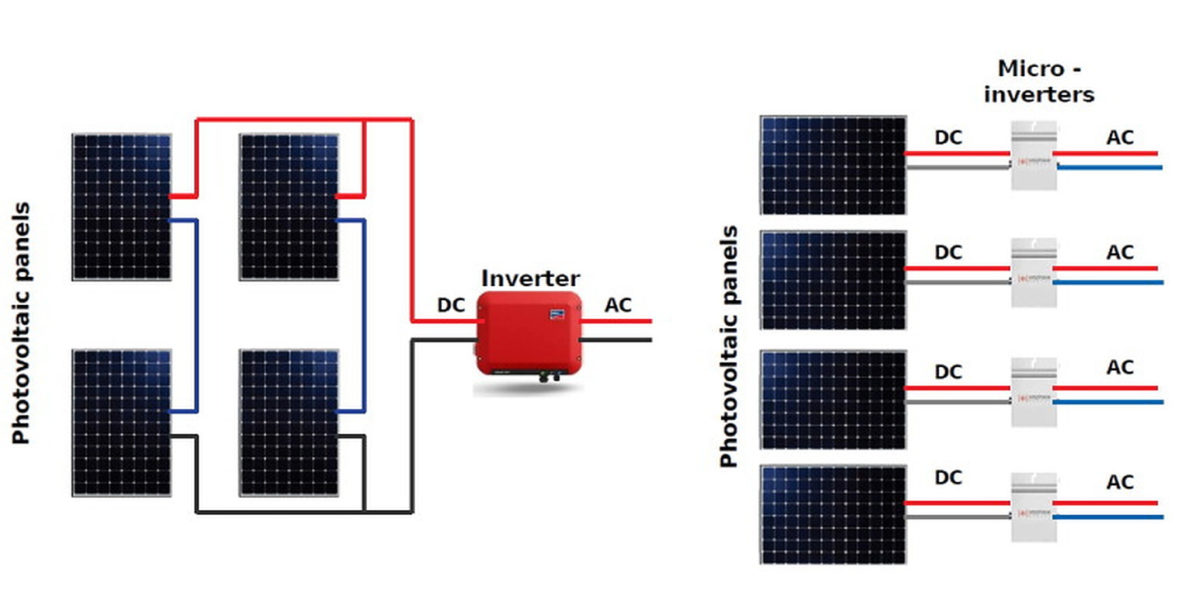A group of researchers from the University of Limoges has compared the performance ratio (PR) of PV systems equipped with micro-inverters to that of installations relying on central or string inverters at several locations across France. Surprisingly, the study finds that micro-inverters do not perform better.
The PR is a parameter that defines the relationship between the actual and expected power production of a PV system, and is largely unrelated to an installation’s location or orientation. This value is used to understand how efficiently the PV system is operating.
The researchers initially analyzed all advantages and disadvantages of an installation with micro-inverters or central/string inverters, and said that micro-inverters should offer an advantage on many points, including price. “We must also consider the lifespans of this equipment, which is a little less than 10 years for a central inverter and can reach 30 years for a micro-inverter,” they further explained. “Micro-inverters also appear to be better suited to reducing the impact of losses that can occur in solar panels whether due to shading or panel malfunction.”
These assumptions were evaluated by analyzing 200 PV installations located in France. The work considered their actual production of solar energy, as well as the orientation, the inclination, the peak power, the geographical area, and other factors. “In order to carry out a statistical study on the PR, 200 data sets were recovered: 100 for installations with Enphase M210, M215, M250 and IQ7 microinverters and 100 with installations using SMA SunnyBoy 3000, SunnyBoy 5000 inverters and Sunny Tripower STP 8000,” the academics explained. “Of the 100 systems, 50 are SunnyBoy 3000 (input power 3.2 kW), 25 are SunnyBoy 5000 (input power 5.2 kW) and 25 are Sunny Tripower STP 8000 (input power 8, 2 kW).”
The average capacity of the installations relying on micro-inverters was 3.8 kW and that of the second category was 5 kW.
The analysis showed that micro-inverters are more sensitive to environmental factors. Furthermore, the scientists found that the size of a PV system doesn't have an influence on the performance of either micro-inverters or inverters.
“According to the production data, the performance ratio is ultimately almost identical for installations with inverters or micro-inverters,” the French group emphasized. “The PR is around 79% for both the average facility equipped with micro-inverters and the average for other facilities.” It also reported slight growth in the PR with lower irradiance for both micro-inverter and central/string devices, which could depend on the inclination and orientation of the panels or the geographical area.
“Finally, the results show a homogeneity of the performance ratio between the two technologies despite different operations,” the academics concluded. “However, even if the performance ratio is identical between inverters and micro-inverters, micro-inverters are still to be favored because of their lifespans and their prices.” They go on to explain that microinverters may not be replaced for an entire 25 year module lifetime, and that they allow stakeholders to better guarantee the safety of the installation even in the event of fire.
Their findings were presented in the paper Performance ratio of photovoltaic installations in France Comparison between inverters and micro-inverters, which was recently published in the Journal of King Saud University – Engineering Sciences.
This content is protected by copyright and may not be reused. If you want to cooperate with us and would like to reuse some of our content, please contact: editors@pv-magazine.com.




What this study tells me, if they’re comparing expected vs. actual performance, is that the system designers were good at accurately estimating the performance prior to installation. This doesn’t indicate whether one system produced more than the other. I’d guess that on a kWh/DC kW basis that the microinverters would outproduce the string inverters.
Yes, true. This is a multi-dimensional optimization problem: With µ-inverters you have a much more granular resolution of production and better exploitation of power, therefore a higher kWh-per-kWp ratio. On the other hand, TCO costs for µ-inverters are significantly higher per installed kWp than for string-inverters and it may be questionable, whether the higher cost will amortize over lifetime of the installation. An interesting optimization case, which cannot be concluded by looking just at a single dimension.
Prefer the mico inverters as you get per panel monitoring and can be installed on all parts of the roof witch would not normally be done with a string setup and are electrically fire safe when grid power is loss
If grid power is loss micro inverts turn off and only have to deal with per panel dc open voltage of 50-70v per panel witch is water safe and is confined to each solar panel
where as string DC voltage can be upwards of 800v all the way to the cut off switch depending on size of installation so it’s a safety hazard for firefighters even if the inverter is off
This study has at least one large flaw. It is using the warranty period ( String vs. Micro inverter ) in place of the lifespan. We replace about 1,000 times as many micro inverters and optimizers for that matter vs. string (properly installed) string inverters. The warranty typically does NOT cover replaceemnt labour also. Ever dig a micro inverter out from under the middle of an array on a roof???